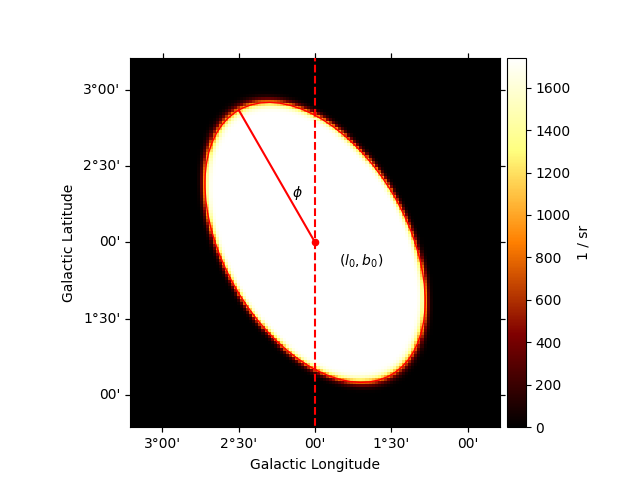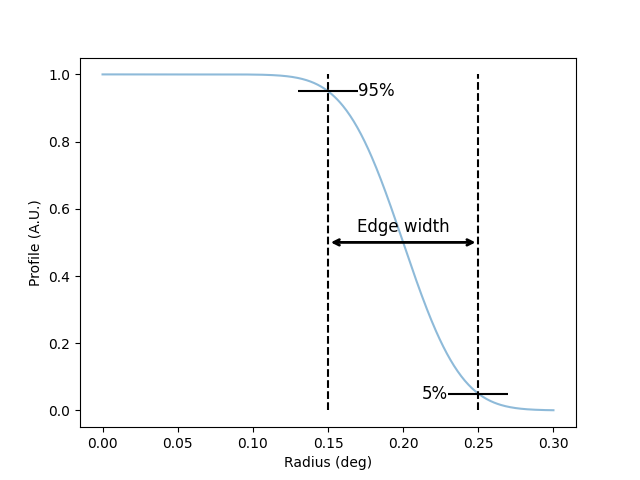Note
Go to the end to download the full example code or to run this example in your browser via Binder.
Disk spatial model#
This is a spatial model parametrising a disk.
By default, the model is symmetric, i.e. a disk:
where \(\theta\) is the sky separation. To improve fit convergence of the
model, the sharp edges is smoothed using erf.
In case an eccentricity (e) and rotation angle (\(\phi\)) are passed,
then the model is an elongated disk (i.e. an ellipse), with a major semiaxis of length \(r_0\)
and position angle \(\phi\) (increasing counter-clockwise from the North direction).
The model is defined on the celestial sphere, with a normalization defined by:
Example plot#
Here is an example plot of the model:
import numpy as np
from astropy.coordinates import Angle
from gammapy.modeling.models import (
DiskSpatialModel,
Models,
PowerLawSpectralModel,
SkyModel,
)
phi = Angle("30 deg")
model = DiskSpatialModel(
lon_0="2 deg",
lat_0="2 deg",
r_0="1 deg",
e=0.8,
phi=phi,
edge_width=0.1,
frame="galactic",
)
ax = model.plot(add_cbar=True)
# illustrate size parameter
region = model.to_region().to_pixel(ax.wcs)
artist = region.as_artist(facecolor="none", edgecolor="red")
ax.add_artist(artist)
transform = ax.get_transform("galactic")
ax.scatter(2, 2, transform=transform, s=20, edgecolor="red", facecolor="red")
ax.text(1.7, 1.85, r"$(l_0, b_0)$", transform=transform, ha="center")
ax.plot([2, 2 + np.sin(phi)], [2, 2 + np.cos(phi)], color="r", transform=transform)
ax.vlines(x=2, color="r", linestyle="--", transform=transform, ymin=0, ymax=5)
ax.text(2.15, 2.3, r"$\phi$", transform=transform)

Text(2.15, 2.3, '$\\phi$')
This plot illustrates the definition of the edge parameter:
import numpy as np
from astropy import units as u
from astropy.visualization import quantity_support
import matplotlib.pyplot as plt
from gammapy.modeling.models import DiskSpatialModel
lons = np.linspace(0, 0.3, 500) * u.deg
r_0, edge_width = 0.2 * u.deg, 0.5
disk = DiskSpatialModel(lon_0="0 deg", lat_0="0 deg", r_0=r_0, edge_width=edge_width)
profile = disk(lons, 0 * u.deg)
plt.plot(lons, profile / profile.max(), alpha=0.5)
plt.xlabel("Radius (deg)")
plt.ylabel("Profile (A.U.)")
edge_min, edge_max = r_0 * (1 - edge_width / 2.0), r_0 * (1 + edge_width / 2.0)
with quantity_support():
plt.vlines([edge_min, edge_max], 0, 1, linestyles=["--"], color="k")
plt.annotate(
"",
xy=(edge_min, 0.5),
xytext=(edge_min + r_0 * edge_width, 0.5),
arrowprops=dict(arrowstyle="<->", lw=2),
)
plt.text(0.2, 0.53, "Edge width", ha="center", size=12)
margin = 0.02 * u.deg
plt.hlines(
[0.95], edge_min - margin, edge_min + margin, linestyles=["-"], color="k"
)
plt.text(edge_min + margin, 0.95, "95%", size=12, va="center")
plt.hlines(
[0.05], edge_max - margin, edge_max + margin, linestyles=["-"], color="k"
)
plt.text(edge_max - margin, 0.05, "5%", size=12, va="center", ha="right")
plt.show()

YAML representation#
Here is an example YAML file using the model:
pwl = PowerLawSpectralModel()
gauss = DiskSpatialModel()
model = SkyModel(spectral_model=pwl, spatial_model=gauss, name="pwl-disk-model")
models = Models([model])
print(models.to_yaml())
components:
- name: pwl-disk-model
type: SkyModel
spectral:
type: PowerLawSpectralModel
parameters:
- name: index
value: 2.0
- name: amplitude
value: 1.0e-12
unit: TeV-1 s-1 cm-2
- name: reference
value: 1.0
unit: TeV
spatial:
type: DiskSpatialModel
frame: icrs
parameters:
- name: lon_0
value: 0.0
unit: deg
- name: lat_0
value: 0.0
unit: deg
- name: r_0
value: 1.0
unit: deg
- name: e
value: 0.0
- name: phi
value: 0.0
unit: deg
- name: edge_width
value: 0.01
metadata:
creator: Gammapy 2.0.dev2532+g99dc4a80a
date: '2025-12-06T05:22:13.132411'
origin: null
